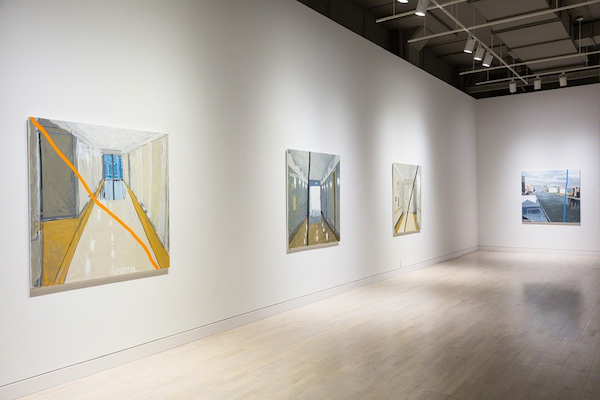Originally published in Art in America’s December 2015 issue. â—Šâ—Š
It is challenging to choose terms to describe the works in Jennifer Bartlett’s recent show at Locks, titled “Hospital.†We are told in press material that the show’s 10 oil paintings, all 54 inches square and made in 2012, are based on snapshots Bartlett took during an extended stay at a hospital overlooking the East River in Manhattan. These intimate details create delicate terrain, where terms like “illness†and “anxiety†are appropriate but could easily be applied too heavily. Likewise, it would be unduly sentimental to view the paintings as straightforward illustrations of autobiographical incident. Yet the series undoubtedly conveys restricted movement in confined spaces, the surprising proximity of fear and banality, and the struggle to comprehend time. These paintings represent and abstract Bartlett’s hospital stay through the use of three layers of visual information, all the while alluding to their own expressive limits.
One layer consists of representational scenes derived from the snapshots: empty hospital corridors or cityscapes at different hours of the day. The views, largely absent any human presence, seem both momentary and prolonged. In this representational register, time is elastic and indeterminable. Space, too, warps as wavering orthogonal lines and tilting buildings destabilize the viewer’s perspective. In an extreme example—a painting of a night scene—the city and its buildings are nearly hidden in a flattened and inscrutable field of black paint.
Additionally, the canvases all contain the word “hospital†somewhere, painted in tidy capital letters in ghostly white. More than naming the domain in which these paintings were conceived, the recurring word is a reminder of the capacities and failures of language as expressive form. Here, “hospital†indeed totalizes an event, and yet is incapable of elaborating on what transpired during Bartlett’s stay. After one sees all the paintings, the word loses its sharpness, becoming naturalized, peripheral. In a limpid blue view of the sky and buildings between two dark window frames, the white letters of “hospital†overlap a cloud, and are thus especially easy to overlook.
The third register is a wobbling line, a bit over an inch thick in a single opaque color, that moves across each painting from edge to edge. The lines appear to be relatives of the curled long marks found in Bartlett’s painting installations like Rhapsody (1976) and Recitative (2009-10). In the “Hospital†paintings, the lines are simultaneously the most abstract and the most corporeal feature. Though they carry no particular signification, one can sense the duration of their execution, an arm-span in length, and perhaps, in their wavering, the rhythm of breathing. The lines contain the immediacy and presence that the modes of representation and language struggle to index.
This is not to say that Bartlett’s painting project gives manifest privilege to any single expressive mode. Painted in retrospect, the “Hospital†works struggle to parse and convey the past in the ongoing present. With complex visual syntax, the paintings suggest the very simple impulse to make sense of lived experience through any and all means possible.
